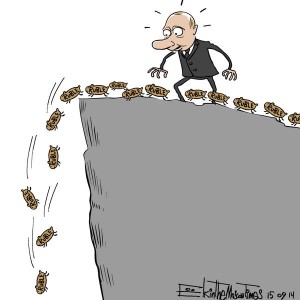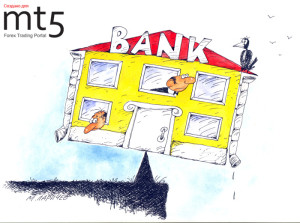 Before 1988, there were no privately owned banks in socialist Russia, and their emergence—after that of industrial cooperatives—was one of the first signs of the coming changes in the Soviet economic system. Menatep, Onexim and Alfa Bank that were founded then became leaders of Russia’s business in the 1990s, not only in the financial sector, but also in industry: they used the capital they had accumulated to acquire the country’s largest industrial plants as part of the privatization process.
Before 1988, there were no privately owned banks in socialist Russia, and their emergence—after that of industrial cooperatives—was one of the first signs of the coming changes in the Soviet economic system. Menatep, Onexim and Alfa Bank that were founded then became leaders of Russia’s business in the 1990s, not only in the financial sector, but also in industry: they used the capital they had accumulated to acquire the country’s largest industrial plants as part of the privatization process.
Unlike the talented and energetic young entrepreneurs, who quickly mastered the new capitalist rules of the game, the country’s top leaders and Soviet bureaucrats who held positions of authority in ministries understood little about finance. The regulation of the banking sector in the 1990s was practically absent, which led to regular bankruptcies of large and small financial institutions that attracted money from the population. These naïve depositors lost their money and became increasingly disappointed in the free market, for which neither they nor the authorities were ready. The reasons for such attitudes are fairly obvious: as a result of the collapse of the planned economy and the monstrous rate of inflation that accompanied the country’s transition to the market, almost every Soviet family lost their savings as they became depreciated. Add to this the widespread financial fraud of the early 1990s—the numerous Ponzi schemes.
The incompetent economic policy of the Russian government led to the country’s default and the four-times devaluation of the ruble in August 1998. Russia entered its first post-Soviet economic crisis, and many banks did not survive it. Those that did became more attentive and more careful in their actions.
In the 2000s, the high global prices of oil, natural gas and other commodities—the main source of Russia’s national income—mollified many. An economy pumped full of money allowed banks to start issuing consumer and mortgage credits to individuals en masse. In late 2003, the federal law “On Insuring Deposits of Individuals” was adopted that established the maximum amount of the banking deposit that the state guaranteed to pay in case a credit institution went bankrupt. This, in turn, led to an increase in public confidence in the banking system.
Thus, by the time the 2009 economic crisis came, Russian banks already held a lot of individual deposits. Evidently realizing the necessity of solving above all the problem of protecting the population from panic that would have been caused by the loss or significant depreciation of deposits, Putin’s government directed more than 70 percent of the budget funds earmarked for anti-crisis measures on supporting the financial sector.
In general, thanks to the “oil cushion”—that is, budget reserves that had been accumulated earlier—the Russian banking sector emerged from the world economic crisis of the late 2000s relatively unscathed. But in 2014, crisis has struck again, this time caused by purely political reasons: the annexation of Crimea and the military aggression in southeastern Ukraine, and the resulting international sanctions against Russia. Meanwhile, global oil prices have dropped by more than half during the second part of 2014, which inevitably led to a devaluation of the ruble.
Having learned from the experience of previous crises, citizens rushed to the banks to withdraw their rubles and foreign currency; some decided to transfer their ruble deposits into foreign currency ones; others began to buy imported goods. Inflation rose immediately.
Many privately owned banks did not survive these disturbances: the liquidity shortage inevitably led to bankruptcies. Even the presence in the credit portfolio of loans to large enterprises did not help—which is not surprising, as the decline in Russia’s industrial output has continued for several years, and the number of private entrepreneurs has been decreasing since 2013. The state is spending its melting budget reserves and borrowing on  the market to prop up the falling ruble, on additional capitalization, and on payments to depositors of the bankrupt banks: in December 2014, the Duma passed a law authorizing the Finance Ministry to issue federal bonds amounting to 2 trillion rubles between 2015 and 2019. One trillion rubles from the funds raised are intended for increasing capitals of Russian banks.
the market to prop up the falling ruble, on additional capitalization, and on payments to depositors of the bankrupt banks: in December 2014, the Duma passed a law authorizing the Finance Ministry to issue federal bonds amounting to 2 trillion rubles between 2015 and 2019. One trillion rubles from the funds raised are intended for increasing capitals of Russian banks.
Meanwhile, the Deposit Insurance Agency that is trying to deal with bank bankruptcies has announced in late January 2015 that its funds will only cover the current bankruptcies; in the future, the Agency intends to take money from the Central Bank.
Thus, instead of creating a healthy economy where financial institutions would function without state support and earn money for their depositors, Kremlin pumps up the banks with budget money. Needless to say, its preference is for state banks, as well as for banks owned by Putin’s friends—for example, SMP Bank that has been placed under Western sanctions and that is owned by the Rotenberg brothers. It is the corrupt/planned distribution, as a result of which—just like in Soviet times—there will be no privately owned banks in the country.





